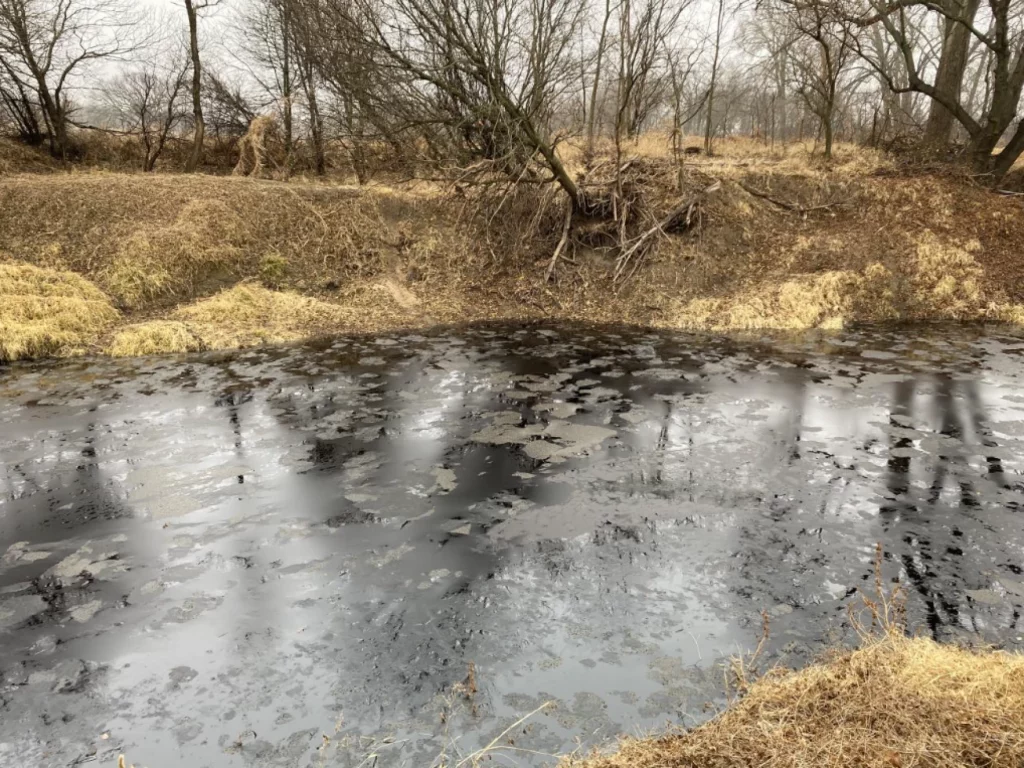Washington County, KS- Chemicals from the Keystone pipeline spill in north-central Kansas have shown up farther downstream in Mill Creek than the oil company’s repeated statements suggest.
TC Energy and regulatory agencies say the oil spill is limited to a containment area — the length of the stream that lies between where the company’s pipeline burst and where workers quickly built an earthen dam about four miles downstream.
Yet state environment officials say benzene, toluene and other volatile organic compounds have been detected beyond the two emergency dams that were installed after the Keystone pipeline’s worst environmental accident to date.
The contamination that migrated downstream of the four-mile, oil-soaked stretch of Mill Creek poses a threat to animals but not to human drinking water, the Kansas Department of Health and Environment said Wednesday.
Two weeks after the Dec. 7 spill, contamination levels remain below a threshold for acute harm to aquatic life, a spokesperson confirmed by email, but they could hurt wildlife that ingests the chemicals through the food chain.
Last Thursday, an official who directs state efforts at the pipeline spill told members of the Kansas Water Authority that public drinking supplies remain safe.
“The downstream public water supply intakes are far enough downstream that — and I never want to say this — (the contamination) will experience a lot of dilution before it gets there,” Erich Glave said. “Dilution is not the solution, but (drinking water) is protected at this point.”
Glave directs KDHE’s Bureau of Environmental Field Services.
Mill Creek flows into the Little Blue River, about 10 miles from the Washington County spill site.
The Little Blue flows into the Big Blue River, which feeds Tuttle Creek Reservoir near Manhattan.
The state says the levels of benzene and other chemicals “remain below our standards in the Little Blue River and downstream in Tuttle Creek Reservoir.”
Glave said people with private wells could reach out with concerns.
“If a private well owner thinks that they’ve been impacted,” he said, “they should contact us and then we can work with them to make sure that TC tests their well, and gets it right.”
TC Energy and the crews it hired are carrying out the cleanup, with oversight, guidance and orders from the EPA and KDHE. More than 600 workers are at the site, including those crews and people from various state and federal agencies.
TC Energy and the U.S. Environmental Protection Agency have kept a tight lid on details at the scene — where the company says about half of the nearly 600,000 gallons of spilled diluted bitumen crude oil have been recovered — so Glave’s public update to the Kansas Water Authority at a meeting in Colby opened a small window into how things are progressing.
Here are details divulged in his update and in emails from a KDHE spokesman since then:
- On Dec. 12 and 13, crews struggled to pick up oil, but then switched equipment. “They’ve switched to a different type of skimmer,” Glave said. “They had a lot more success. … It was taking three or four hours to load one vac truck. (But after the switch,) as quick as the vac truck could pull up and load and pull off, they were going.”
- KDHE has gathered and submitted samples upstream and downstream of the spill site to study the contamination. Lab results pinpointing chemicals released by the spill aren’t finalized yet, but will be released later.
- TC Energy is using special tanks to separate water from oil and chemicals by decanting, filtering it and forcing volatile compounds to vaporize.
- Workers also inject air into Mill Creek to make some chemicals evaporate.
- Water continues to flow downstream through culverts in the emergency dams. One dam has a 4-foot-wide culvert. The other has a 4-foot wide culvert and a 2-foot wide culvert.
- Agencies and TC Energy have discussed a way to divert Mill Creek around the 4 miles of tainted streambed to isolate that stretch. KDHE says that remains under consideration but is “not currently being implemented.”
- The state prompted TC Energy to send out more workers in search of harmed wildlife.
- Workers from the Kansas Department of Wildlife and Parks are also on the site, assessing impacts to vertebrates and invertebrates.
- TC Energy quickly stripped soil from five acres of land coated in oil. “The good thing about this sticky oil is it didn’t migrate through the soil,” Glave said.
- Contaminated soil will likely go to Rolling Meadows, a landfill near Topeka, pending special authorization, where the state says it will be able to monitor for leaching.
Diluted bitumen, or dilbit, spills pose special risks to the environment because this particular type of crude oil sinks, part of a weathering process that can start within days.
When that happens in moving water, a National Academies of the Sciences report says, “there are no proven techniques for containment. … Various techniques have been proposed but few have been shown to be effective.”
A state lawmaker who attended a briefing with TC Energy on Monday said the company maintains that its spilled dilbit hasn’t begun sinking yet. But the company didn’t explain how it could tell, Johnson County state Rep. Rui Xu said.
TC Energy hasn’t answered questions from the Kansas News Service about how it will detect or protect against underwater dilbit migration.
The state says water exiting the dammed area doesn’t contain visible oil.













